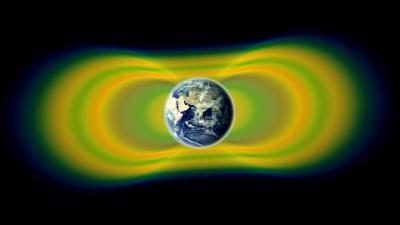Over a year after being launched, NASA's Van Allen Probes mission continues to unravel the mysteries of Earth's high-energy radiation belts that encircle our planet and pose hazards to orbiting satellites and astronauts - termed the Van Allen Radiation Belts.
The Van Allen radiation belts in in the Earth's upper atmosphere were discovered in 1958
and are two doughnut-shaped rings of highly charged particles - an inner ring of high-energy electrons and energetic positive ions, and an outer ring of high-energy electrons. And sometimes a third one.
The newest discovery reveals that the high-energy particles populating the radiation belts can be accelerated to nearly the speed of light in conjunction with ultra-low frequency electromagnetic waves operating on a planetary scale. This mode of action is analogous to that of a cyclical particle accelerator like the Large Hadron Collider. However, in this case, the Earth's vast magnetic field, or magnetosphere, which contains the Van Allen belts, revs up drifting electrons to ever-higher speeds as they circle the planet from west to east.

Two giant swaths of radiation, known as the Van Allen Belts, surrounding Earth were discovered in 1958. In 2012, observations from the Van Allen Probes showed that a third belt can sometimes appear. The radiation is shown here in yellow, with green representing the spaces between the belts. Credit: : NASA/Van Allen Probes/Goddard Space Flight Center
The recent finding comes on the heels of a related discovery showing similar particle acceleration but on a microscopic rather than a planetary scale.
"The acceleration we first reported operates on the scale size of an electron's gyromotion—it is a really local process, maybe only a few hundred meters in size," notes Harlan Spence, director of the University of New Hampshire Institute for the Study of Earth, Oceans, and Space and co-author on paper. "Now we're seeing this large-scale, global motion involving ultra low-frequency waves pulsing through Earth's magnetosphere and operating across vast distances up to hundreds of thousands of kilometers."
And, Spence adds, in all likelihood both processes are occurring simultaneously to accelerate particles to relativistic speeds.
Understanding the complex dynamics of the particle acceleration will help scientists make better predictions of space weather conditions and, thus, offer better protections to orbiting satellites crucial to modern-day society.
Having twin spacecraft making simultaneous measurements in different regions of nearby space is a key part of the mission as it allows the scientists to look at data separated in both space and time.
"With the Van Allen Probes, I like to think there's no place for these particles to hide because each spacecraft is spinning and 'glimpses' the entire sky with its detector 'eyes', so we're essentially getting a 360-degree view in terms of direction, position, energy, and time," Spence says.
Adds Ian Mann of the University of Alberta, first author of the paper, "People have considered that this acceleration process might be present but we haven't been able to see it clearly until the Van Allen Probes."
What this provides is the ability to decipher actual changes in the surrounding region rather than encountering something that looks different but may simply be the result of a single-point measurement with a limited perspective.
With the discoveries, scientists are starting to unravel the different pieces of the puzzle for any particular particle event that changes the structure of the radiation belts. Ultimately they hope to be able to understand the dynamics well enough to actually predict how, collectively, all these different conditions working in tandem make the belts either move in or out, inflate, deflate, change energy, or lose or gain particles.
Says Spence, "What we hope for are those serendipitous occasions when nature has accentuated one process above all others, which allows the spacecraft to really see what's going on. We want to know how the whole system causes one phenomenon or process to dominate or have a lesser influence compared to another one, and we're gaining a much deeper understanding of that."
Nature Communications. Source: University of New Hampshire





Comments